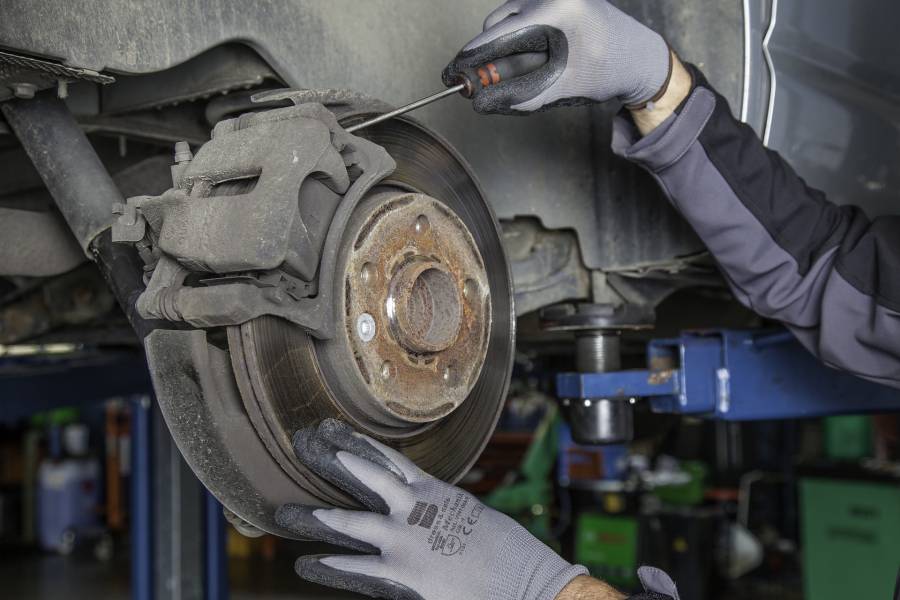Quick Navigation
Most people don’t pay much attention to the parking brake during regular car maintenance.
Still, this brake plays a vital role in enabling you to park your car on sloppy or slanted grounds.
Therefore, knowing what makes it malfunction will help you take precautionary measures to ensure that it is always in good condition.

Also, you will know what to do when you diagnose the issue, especially when you can’t get to a mechanic station any time soon.
Below are the major causes of this issue and how you can solve them.
1. Driving With An Engaged Parking Brake
Sometimes when you have a lot going on in your mind, you get into your car and drive it off without disengaging the parking brake.
But do you know that this can cause the parking brake to malfunction? The brake will overheat due to the friction between the wheels and its surface when you do so.
An overheated braking system will not last for long; it is always recommended to release the parking brake before driving.
Besides, you should check this brake now and then to ensure that it is still in good shape.
2. Faulty Cable
The parking brake cable can get worn if left idle for long. It develops rust that corrodes and makes it snap when the brake is applied.
Encountering a failed parking brake can be annoying, especially when you want to use it. Therefore, you should frequently use the parking brake to avoid this scenario.
You can apply the brake even when not parking the car on a steep surface.
3. Damaged Springs
One key feature of the parking brake is the locking system that locks itself until you let it go. As such, it has springs that enable it to operate efficiently.
Unfortunately, these springs can wear out due to prolong usage, thus making it hard for you to engage or disengage the parking brake.
If this happens when you are in the parking space, you might waste a lot of time waiting for a mechanic expert.
You should thus check the condition of your brake’s springs more often to avoid getting into this problem.
4. Worn Shoes
For the parking brake to work, there must be a firm grip between it and the wheels. It is made possible by the existence of brake shoes.
But due to friction, these shoes tend to wear over time. Worn shoes will not enable the brake system to work correctly.
It will, in turn, cause your car to move and even roll when it is parked on hilly ground. The good thing is that you can quickly solve the problem by replacing the faulty brake shoes.
5. The Brake Shoes Are Positioned Poorly
When the brake shoes are wrongly positioned, they make the parking brake not work. They will not provide proper and firm contact with the wheels.
Hence, you will have to readjust the shoes to eradicate the problem.
But before doing so, you should first remove the drums, wheels, rotors, and cables to access and correct their positioning.
6. Wet Brakes
Do you know that the presence of moisture can cause a brake to malfunction? Moisture will make the parking brake slide instead of providing a solid grip on the wheels.
Therefore, the wheels will still move even when the parking brake is engaged. Luckily, this issue is temporary and can easily be fixed.

You can make the car vibrate by engaging the braking system while in gear one to solve it.
The moisture is shaken off as the car vibrates, and the parking brake slowly returns to its perfect condition.
To avoid this problem altogether, try to minimize driving your car through potholes filled with water or rain.
It will keep the braking system dry at all times, thus ensuring the car doesn’t roll over due to a malfunctioned brake.
7. Faulty Sensor
The parking brake system has a sensor that tells you if the brake is engaged or disengaged.
It does so by sending signals to the dashboard, producing a specific light or sound. However, this sensor can get faulty, making the system misbehave.
When it gets faulty, the dashboard might signal that the parking brake is engaged when it is not.
If the parking brake malfunctions due to a faulty sensor, you can fix it by repairing or replacing the sensor.
You must sort it out as soon as you can to avoid the stress of not knowing if the brake is engaged or not.
8. Cold Weather
Have you ever tried moving your car in cold weather for a small distance and then parking it? What normally happens?
The parking brake fails to engage! Cold weather makes it freeze, thus creating a vast distance between the brakes and the wheels.
It can make you panic since the cost of fixing it comes to your mind. Fortunately, you can quickly solve this problem by giving the car some time to warm up.
In most cases, when you let the car run for around three minutes, the parking brake loosens up and starts working.
9. Loose Nut
Another thing that can make the parking brake malfunction is a loose nut. This nut attaches the cable to the handle, and it can get loose over time.
It can also get loose when you allow a less expert mechanic to repair or do the system’s regular maintenance.
When it does, the cable will no longer be firm when the brake is applied. It will make the parking brake not engage every time you pull the handle.
But this shouldn’t scare you at all since, with just a screwdriver, you can tighten it yourself.
This issue is less common and should always come last when diagnosing the reasons behind a failed parking brake.
10. Extreme Force
Do you know that applying extreme force can make the parking brake malfunction?
For instance, the cable might snap, making the brake fail. You will generally notice this issue in vehicles that carry heavy loads or those driven in rough terrains.
Although it is challenging to avoid applying excess force on the car, the best thing to do is only apply it when necessary.
Also, it is advisable to do regular maintenance of the parking brakes that are accustomed to excessive force.
To Summarize
Your car’s parking brake plays a significant role and should always work typically. But there are times when it malfunctions, making it hard to engage or release it.
It can arise due to several factors such as faulty cable, worn shoes, loose nut, issues with springs, etc.
Therefore, you should fix them immediately to use the parking brake when you need it the most.
The fantastic thing is that with little expertise and the right tools, you can repair any of the damaged parts yourself, thus saving you maintenance costs.

Patrick started his love affair with cars in his childhood. Over the years, he claims a sturdy hold on his driving skills, along with a thorough understanding of cars. We can expect some interesting, holistic, and pleasurable blogs with his flair for writing and his love for cars.
Being a car enthusiast, Patrick has experience comprising of two decades in which he has ridden some of the meanest and strongest machines in the automotive industry. His previous avatars include an automotive professional, photographer, and journalist, and you will certainly experience the roundness of experience in his piece on this site.
In his second decade of reviewing cars and analyzing tools, Patrick is all set to give you convincing, reliable, and the latest information regarding what’s happening in the automotive industry. Currently, he owns a BMW Z3 but cannot get his eyes off Aston Martin DB5. He is a car enthusiast; he loves cooking and listening to music, especially jazz. Here are some of the pieces written by our ace author.






